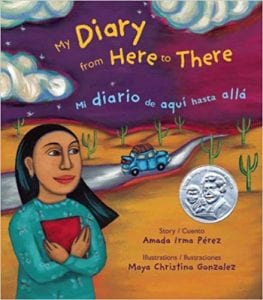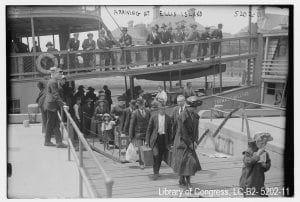Immigration is a hot button issue in the United States and around the world. Therefore, it is likely that students as young as elementary school have heard about immigration in some way or another. Because students may have varying background knowledge on the subject, it is important to fill in any gaps and correct misconceptions about why people immigrate, who immigrants are, and why immigration has always been a hallmark of the United States.
Here are five tips to consider when teaching young learners about immigration.
1. Begin with discussing why people emigrate

Immigration discussions should begin with considering why a person may want to leave their home country, or emigrate. Students should understand that leaving one’s country is very challenging, and it is a big decision that immigrants do not take lightly. Many immigrants leave their country because their home or land is destroyed by a natural disaster or war. Other people may not be able to find work to support their families, so they journey to countries with more available jobs. Some countries have dangerous, unstable governments, or are afraid of new or existing laws that reduce their freedoms. Population Education’s free lesson plan People on the Move is a hands-on simulation that helps students analyze the push/pull factors of immigration. Although designed for middle school students, teachers can easily adjust the activity for elementary scholars. After the simulation, be sure to brainstorm a variety of reasons that people may want to leave one country to live in another.
2. Introduce students to stories from real immigrants

There are many fantastic resources to help students learn about the lives of immigrants and draw similarities to their own life. The book I was Dreaming to Come to America by Veronica Lawlor contains dozens of stories from the Ellis Island Oral History Project. Ranging from ages six to thirty, the passages are first person accounts of the thoughts and dreams of children immigrating through Ellis Island. By analyzing these primary sources, students interpret history though new perspectives while developing both critical thinking skills and empathy. Another children’s book on immigration is My Diary from Here to There/Mi diario de aqui hasta alla by Amada Irma Perez. Perez retells the story of her family leaving Juarez, Mexico to find work and a better life in Los Angeles, CA. The book contains diary passages in both English and Spanish, making it perfect for bilingual classes. The diary captures Amada’s internal thoughts, fears, and excitement – emotions to which any student can relate.
3. Teach through the history of America

It may be cliché, but it is true: America is a country of immigrants. And teaching about immigration is teaching the history of America. Starting with a discussion of the Statue of Liberty, explain to students what the iconic monument represents to the millions of Americans who passed through Ellis Island. Population Education recommends the book Coming to America: The Story of Immigration by Susannah Ryan as a read aloud focusing on Ellis Island. You could also explore the Statue of Liberty-Ellis Island Foundation website, where students can investigate primary source documents, timelines, databases from Ellis Island and even take a virtual tour using Scholastic’s immigration activity guide.
Depending on the demographics of your students, there is a good chance many of them have relatives who immigrated to the United States. Using PopEd’s lesson plan Family Roots, have your students interview their family members and gather information about where their relative was born, the reasons they moved, and where they live now. Allow students to share with their classmates in order to build understanding of the diverse backgrounds of their peers.
4. Understand that not all Americans chose to come here
It is important to acknowledge that while many people made the choice to leave their country of birth and come to the U.S., millions of people were brought to America against their will. Beginning in 1619, millions of Africans were taken from their home countries and forced into slavery in the United States. Students must understand that this is very different from immigration. While immigrants left home in search of freedom and better lives, enslaved peoples lost their rights as free men and women. For resources on teaching about slavery, we recommend using The Pulitzer Center’s curricula based on the New York Times 1619 Project.
5. Discuss immigration today
As the world has changed, so has immigration. Ask your students simple questions about how they think immigration has changed since the days of Ellis Island such as:
- How do you think people travel to the United States today?
- Where do you think most United States immigrants today come from?
- How do you think the United States decides who is allowed to stay in the country?
- What happens when immigrants arrive in the United States?
Most immigrants today travel the same way as your students – by car or airplane. More than half of all immigrants now come from Mexico or other countries in Latin America. Others come from many different countries across Asia and Africa. This differs significantly from the early and mid-1900s when so many immigrants were arriving from European countries, yet many of the push/pull factors discussed above remain the same.
There is a lot of debate about whom the government should let into the country. Most immigrants, about 70%, arrive because they have family members already established in the United States or know someone who is willing to sponsor them. The United States also accepts refugees, or people who leave their country because they fear for their safety. However, due to increased vetting procedures and policy changes, the number of refugees accepted into the U.S. has decreased significantly in recent years to only 22,000, or roughly 5% of the total number of immigrants in 2018 .
Explain to your students that once a person immigrates to the United States, they are not automatically a naturalized citizen. Immigrants who choose to become citizens must fill out a lot of paperwork and live in the country for 5 years before applying for citizenship. They also must pass a citizenship test. You can challenge your students to take the test through Scholastic’s kid-friendly U.S. Citizenship Test.
More Resources for Teaching Immigration
For additional student resources check out lesson plans from the Library of Congress, Teaching Tolerance, Scholastic, and follow Population Education on Facebook this fall while we focus on the theme of migration. For more background information about immigration policy and statistics, explore the U.S. Census Bureau’s online resources for teachers.
Image credits: Suitcases by Nick Fewings on Unsplash; Book cover (Amazon); Immigration at Ellis Island (Library of Congress); Travel documents by Popartic (Royalty-free stock photo ID: 155894303)



